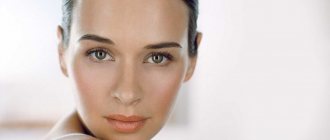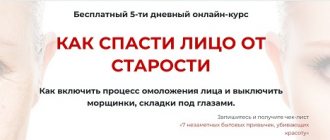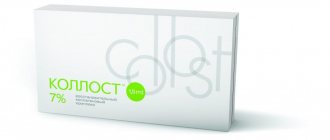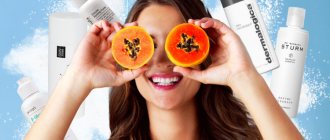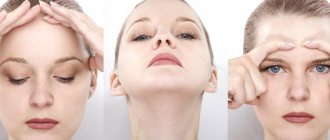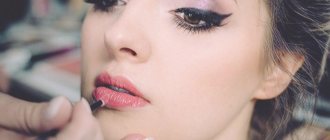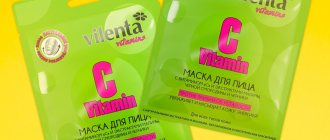Collagen is one of the structural proteins of human skin, which performs the function of moisturizing and protecting it from the negative effects of external factors and free radicals. Special cells of the dermis - fibroblasts - are responsible for the formation of collagen fibers. With age, the activity of these cells decreases, resulting in the appearance of wrinkles and changes in the oval of the face.
Regular use of cosmetics containing collagen helps slow down the aging process, prolonging the youth and health of the skin.
What is collagen
Collagen is a protein fiber that forms the bulk of the body's connective tissue and provides its strength. Contained in skin, muscles, tendons, ligaments, cartilage, joints, etc.
We are only interested in collagen in the skin. To understand exactly where it is located, imagine the structure of the skin.
Following its top layer (epidermis) comes a supporting layer - the dermis. The dermis consists of cells (20%) and an intercellular matrix (80%) - a kind of cellular “glue” that binds cells together. The youth of our face depends on its condition.
What does the extracellular matrix look like? This is a kind of “framework” of protein fibers (collagen and elastin), which is immersed in a liquid, gel-like medium (hyaluronic acid). An image that will help represent these matrix components is a spring mattress. Collagen and elastin are the “springs”, hyaluronic acid is the “filler”.
And the basis of this “framework” is collagen. It accounts for 70% of the protein mass in the dermis.
It is easy to imagine each such collagen “spring”. It looks like three threads that twist in a spiral. These strands are made up of a chain of different amino acids.
Depending on the set of amino acids, more than 20 types of collagen are distinguished. Only some of them are synthesized in the human body. For youthful skin, collagen types I and VII are most important.
Effective skin rejuvenation can be achieved in two ways:
- delivery to the dermis of substances that stimulate the natural production of collagen, preferably not only types I and III (types IV, V, and VII are also important, for example);
- stimulation of fibroblasts so that they don’t become lazy after 30 years and continue to produce collagen as they did at 18.
Building material can be delivered to the skin in two ways: by adding the necessary elements to the diet or by performing an injection procedure (introducing the necessary elements using injections). The first way takes longer and has a cumulative effect, the results of the second can be assessed almost immediately after the procedure.
In order for your skin to be healthy and youthful, your diet must include:
- vitamin C in sufficient quantities;
- copper (cod liver, spinach, cocoa powder, beef liver);
- pyridoxine (vitamin B6): pistachios, garlic, beans;
- zinc (oysters, wheat bran, eel, sesame);
- sulfur-containing compounds - sulfur, glutamine (rabbit, chicken breast, turkey, egg powder);
- selenium (pistachios, walnuts, beans and lentils, broccoli, tuna);
- silicon (unpolished rice, oats, millet, barley).
Let us separately note those compounds and substances that stimulate the work of fibroblasts :
- vitamin A (fish oil, beef liver, carrots);
- vitamin D (fish oil, cod liver, fatty fish, seafood);
- peptides.
If you manage to create a diet of all the listed products with minor deviations, after 6-9 months your skin condition will noticeably improve!
Why is it needed?
Collagen supports the skin from the inside, like springs support a mattress. He is responsible for its strength and elasticity. That is, the skin is not damaged when stretched and does not change its structure precisely thanks to collagen. It seems to “spring”: it stretches and returns to its original shape.
This fixing role of collagen is also indicated by its name. From Greek kola – “glue”, gen – “to create”.
Collagen depends on:
- skin elasticity,
- tightened oval,
- smooth relief without wrinkles,
- shape and proportions of the face.
But what exactly happens to collagen when age-related changes begin? Most of us don't know the answer to this question. Instead, they believe in dangerous myths that are spread by cosmetologists.
Differences between collagen types I and III
We found out that all kinds of dietary supplements with collagen are useless for the skin. Only natural products are effective, although you should not refuse the help of cosmetologists.
So, how can our specialists help?
To begin with, we note that cosmetologists see significant differences between type I collagen and type III collagen :
- collagen type I (fibrous) predominates in the skin composition (about 60%), has an uneven and dense structure;
- Type III collagen (reticular) is the most desirable because it is responsible for the youth of the skin, its fibers are smooth, slender, with excellent elasticity.
When damaged, type III protein turns into type I. For example, our scars and scars are made entirely of type I collagen.
Myths about collagen
From all corners of the Internet, cosmetologists shout with one voice that aging is associated with a reduction in the level of collagen in the dermis. We are convinced that we need lots and lots of new protein to stay young. As a means of salvation, they offer collagen injections, cosmetics, dietary supplements, which are supposedly capable of filling our skin with collagen in incredible quantities.
How much of this is true? NOTHING.
Myth: Collagen in the skin decreases with age, so it needs to be replenished.
Fact: Collagen accumulates in the skin over the years in the form of clumped fibers and debris, creating a lifeless, dense web. Its amount becomes critical and prevents nutrients and moisture from accumulating in the intercellular matrix and reaching the cells.
That's why:
- Our skin doesn't need more collagen than it has.
- On the contrary, its task is to get rid of the accumulated collagen “ballast”.
- For youth, it is not the quantity, but the quality of collagen that is important.
- Injections, creams, and dietary supplements containing collagen do not work.
- The most effective way to improve the quality of your own collagen is self-massage + a healthy lifestyle.
Now let's talk about everything in order.
Myths and truth about collagen
Doctor of Technical Sciences, Professor A.I. Sapozhnikova
The modern cosmetology, medical and biotechnological industry can hardly be imagined without collagen. This fibrillar protein is perhaps best known today both to specialists and ordinary consumers. Unfortunately, this “fame” is often false, based not on genuine scientific facts, but on unfair advertising and aggressive marketing, which is very far from not only science, but also from common sense. I would like to dispel myths about collagen and restore the truth.
For more than forty years I have been involved in the recycling of waste raw materials of animal origin, containing fibrillar proteins that are unique in their properties: collagen, elastin and keratin. For many years I led research into such a multicomponent and multifunctional system as raw materials of animal origin. With my direct participation, methods for extracting highly purified monoproducts from protein-containing waste in the form of collagen, elastin and keratin preparations solubilized to the state of macromolecules, retaining their biological activity due to an undisturbed tertiary structure, have been developed, protected by 6 copyright certificates and 22 patents, and also put into practice.
This technology has made it possible to use solubilized fibrillar proteins as a base or special additives for cosmetology, medicine, veterinary medicine, biotechnology, and other industries.
So, collagen. The “passions” around this biopolymer have either subsided or flared up with renewed vigor since the 30s of the last century, which is not surprising, given its enormous industrial and commercial potential. Collagen is perhaps the most ancient phylogenetically major protein of connective tissue. In the body it performs mechanical, nutritional, protective and reparative functions. Collagen is non-toxic, non-carcinogenic, practically non-antigenic, has a good regenerating and hydrating effect, high biocompatibility, the ability to form structures, form complexes with biologically active and medicinal substances, biodegradation, as well as a number of other useful properties.
That is why, for many decades, collagen, as a product with real biological activity, continues to be a popular ingredient in cosmetic formulations for the care of face and body skin, as well as hair.
Let me note that the term “collagen” is to a certain extent a collective term. It refers to both specific monomeric protein molecules and hydrolysis products of collagen-containing tissues.
Today, the market for cosmetic raw materials offers a wide range of collagen preparations produced by domestic and foreign companies. Sources of collagen are: tissues of mammals - cattle (cattle), waste from the poultry processing industry, as well as waste from fish processing production.
Myth 1
The raw material from which collagen is obtained is associated with the most persistent and at the same time absurd misconception in the mass consciousness. Namely, that collagen from bovine tissue is supposedly the worst collagen: dirty, cheap, causing allergies. Unlike fish, which advertising presents as “high quality and expensive.”
This misconception began in the late 90s with the spread of the spongiform encephalopathy virus, better known as the mad cow disease virus, that spread throughout the world. The “hot” topic was picked up and incredibly inflated by the media, turning it into another “horror story” for the masses, which is why society has developed a wary attitude towards drugs of animal origin, including collagen from cattle tissue. However, the interest in this biopolymer among specialists was so great that scientists from different countries tried to find an alternative to animal protein. Therefore, in 2000, a large project was launched in Europe to study collagen from marine fish processing waste.
Several large cosmetics manufacturers have invested enormous amounts of money in the invention of this “bicycle”, and are now striving to recoup the costs - business is business.
As a result, we have many examples of dishonest advertising that deceives consumers. In particular, it is widely stated that fish collagen is closer to human protein than animal protein and therefore, they say, it is less allergenic. The stupidity of this statement is obvious to anyone who is even superficially familiar with evolutionary theory. Are humans and fish closer phylogenetically than, say, humans and pigs? Organ transplantation from pigs is an example of this. In addition, it is well known that fish protein is the second most important food allergen (after dairy products).
At the same time, important facts about fish collagen are unknown to consumers. For example, this: fish collagen is not heat-stable; its molecular structure disintegrates at 23-25°C, since fish have a lower body temperature. Since not a single advertising genius can explain the beauty of denaturing a protein molecule at room temperature, this circumstance is simply hushed up. As well as the fact that fish collagen is expensive not because it is of high quality, but because, firstly, it requires much more raw materials and, accordingly, is much more expensive. And secondly, due to its low thermal stability, it is very capricious in production and transportation. That is why fish collagen is usually supplied to consumers in the form of denatured protein, which is incomparable in effectiveness to native protein.
As for collagen from cattle tissues, in an impartial comparison it outperforms fish protein in all respects. Namely: in terms of the cost of production, the thermal stability of the protein, and its allergenicity.
The production of animal collagen is economically efficient. From 1 kg of animal raw materials you can get up to 15 liters of collagen, since it is a very moisture-intensive protein.
Thermal stability of native collagen from cattle tissues is 31-33ºС, i.e. it is not in danger of destruction at room temperature. By the way, this is how you can distinguish denatured protein, which is sometimes passed off as native collagen. For example, when a manufacturer for use in cosmetology suggests first melting “living collagen” from poultry (very similar in appearance to jellied meat) in a water bath.
And the last indicator is allergenicity. If you compare animal and fish collagen, the first one “wins” by a wide margin.
The problem of infection through collagen with the mad cow virus is far-fetched, since raw materials are taken only from healthy animals raised in areas where cases of rabies are unknown. Each animal goes through strict documented veterinary control. Finished products are also thoroughly checked. Toxicological studies of collagen in the concentrations in which it is usually added to cosmetics have shown that this protein is safe, it does not irritate the skin, does not increase the body’s sensitivity to components that can cause allergies, and does not damage the mucous membranes of the eye and the cornea.
Myth 2
The range of collagen preparations on the market is represented by both native forms and hydrolysis products. And the next very common myth is that peptides, unlike native protein molecules (too large to overcome the epidermal barrier), supposedly penetrate the dermis and stimulate the synthesis of its own collagen. Unproven assurances that hydrolyzed collagen penetrates through 5 layers of the epidermis deep into the dermis, causing the body's immune response, and thereby stimulating the synthesis of its own protein, have no scientific basis. Even hypothetically passing through the epidermis, the hydrolyzate will not be able to stimulate fibroblasts to synthesize collagen.
For those who spread this myth or fall for its bait, I would like to remind you that a living organism always protects its homeostasis using resistance mechanisms in order to avoid disruption of vital functions. Therefore, the body can fully use only the collagen that it synthesizes itself.
And one more important note: for cosmetics it is much more important that their ingredients do not penetrate into the dermis, and from there into the blood through the capillary system. After all, the entry of a product through the skin into the circulatory system transfers it from the category of cosmetics to the category of medicine.
Also absurd are the claims of some companies about restoring the internal structure of hair with collagen “at the molecular level” due to the penetration of low molecular weight collagen peptides into the hair. The main building material of hair is the protein keratin, and “scraps” of collagen molecules cannot replace it in any way.
For manufacturers, the choice between native triple-stranded bioactive protein and hydrolyzed collagen is often an economic issue. The hydrolyzate is cheap and relatively easy for technologists to use. For the consumer, the difference in the effectiveness of the final product is the same as between fillet and cheap sausage.
Myth 3
The third myth about collagen is being actively created today, right before our eyes. It says: collagen is what we call collagen. This myth is based on the unscrupulousness of people who speculate on the “collagen” brand, on the one hand, and the ignorance of consumers, on the other. A striking example of such widespread speculation is the so-called “plant collagen from wheat proteins.” Plant proteins may contain collagen-like fragments, but calling them collagen is like calling soy meat. Collagen is exclusively an animal protein; plants cannot synthesize it.
Another example is an attempt to pass off as collagen “an extract from collagen-containing poultry raw materials” - in fact, a multicomponent “soup” of low and high molecular weight polypeptides, uronic acids, hexosamines and minerals. And on this basis, declare that such “collagen” is highly effective, that it is many times better, “more alive”, and more effective than other products. The point here is not even whether it is better or not - this still needs to be proven in clinical trials, but the fact that this natural complex is not collagen. You need to be honest in your definitions. If the collagen content of a product is more than 90% relative to the dry residue, then it is collagen. And if there are “15 proteins,” as the manufacturer proudly declares, then what degree of purification, what quality, what bioactivity of the collagen itself can we even talk about in this case?
Native triple helix collagen has a number of quality indicators shown in the table below.
Brief technical dossier on BIOACTIVE COLLAGEN 10.11.60-001-64516066-2017
| Indicator name | Characteristics and norm |
| Appearance | The liquid is viscous, slightly opalescent |
| Color | Colorless |
| Smell | Specific |
| Hydrogen value (pH) | 3,5-4,5 |
| Authenticity | Positive reaction with 4M NaCl to native collagen |
| Inclusion in formulations | Any, except alcohol-containing ones, taking into account the pH of the product |
| Thermal stability | Up to 33°C |
| Colloidal stability | Stable |
| Shelf life | 1 year |
This is the standard for what is collagen in terms of correct definition. It is this product data that technologists should request from suppliers to be sure that they are purchasing collagen and not something disguised as it.
An indicator of bioactivity is the fact that cells grow on native collagen. It is this protein that is used to make drugs that promote tissue regeneration (Fig. 1).
Fig.1. Dynamics of formation of a monolayer of cells on positively charged microcarrier granules coated with bioactive collagen after 10 (a), 24 (b), 72 (c) hours.
The use of collagen in cosmetology increases the effectiveness of skin care products, despite the fact that, due to its large mass, the collagen molecule is not able to penetrate into the deep layers of the dermis. The mechanism of action of native collagen in skin cosmetics is as follows. Thanks to its moisture-holding ability, it has a pronounced moisturizing effect, increases skin elasticity, prevents the appearance of wrinkles, and has a high protective and antioxidant effect. Due to its biological activity, native collagen promotes effective regeneration of skin cells. It also serves as the main structure-forming component of a cosmetic composition, acting as a matrix on which the remaining active ingredients are immobilized by inclusion in the gel, whose action is thus enhanced and prolonged.
In recent years, these properties of native collagen have become in demand in hair care products. When included in shampoos, it helps maintain the lipid barrier on the scalp and hair. As part of masks, collagen forms a protective layer on the hair and helps smooth the cuticle and reduce hair dryness. During comparative tests of native collagen and hydrolyzed forms, it was found that native collagen gives a more pronounced and lasting result, as well as a stable external cosmetic effect in hair care procedures.
In conclusion, I would like to once again emphasize the importance of consumers receiving reliable, scientifically based information about cosmetic ingredients. After all, he who is forewarned is forearmed, which means he will not spend money buying cosmetic ingredients and products in advertising of which the desired effect is presented as actual.
Materials used with permission from www.cosmetic-industry.com
How collagen in the skin decreases
With age, it is not the amount of the treasured protein that decreases (it actually increases), but its synthesis. That is, the production of new collagen slows down. And this is not a myth, but a fact.
It is believed that after 25-30 years, our skin reduces collagen production by 1-1.5% per year. At this rate, by menopause, a woman loses about a third of her renewed collagen (the old one does not go away and accumulates).
Some cosmetologists have more radical “statistics”. On the Internet you can find information that young skin produces about 6 kg of collagen per year, and after 35 years it reduces “production volumes” by half, but by menopause the synthesis practically stops.
Such data is a strong condensation of colors. In fact, new collagen is produced in the skin at 45, 50, 60 years old, and later, just in smaller quantities. And taking into account the deposits of “old” protein, the collagen mass only grows.
If it's not a matter of quantity, then what is it? That's right, in quality.
Japanese collagen from AFC 1000
The food supplement AFC Collagen starts the regeneration processes of the dermis. With regular use of the product:
- the body activates its own collagen production processes;
- the firmness and elasticity of the skin is restored;
- The visibility of wrinkles and open pores is reduced.
The dietary supplement is available in the form of tablets. In addition to collagen, the product contains shark cartilage extract, which increases skin elasticity and vitamin C, which enhances the synthesis and speed of absorption of collagen.
How are age-related changes related to collagen?
Age-related changes are explained precisely by the quality of collagen, which deteriorates over the years. Its fibers become damaged, break, and stick together. And all this “garbage” accumulates.
The extracellular matrix is “cluttered” with protein fragments and cross-links. This is no longer a frame, but a “cemetery” of “dead” collagen (+ elastin). The stitches tighten the face with a dense network. The dermis seems to stick together with the covering layer, blocking the mobility and interaction of tissues with each other.
Such accumulations of damaged collagen are ballast that turns the fluid extracellular matrix into a dense, lifeless mass. In it, cells lose their former mobility and cease to receive moisture and nutrients in the same quantities (since the pathways are blocked by “clogs” of collagen cross-links and debris).
Wrinkles, sagging and roughening of facial skin are external manifestations of the fact that our face is covered with a tight web of lifeless collagen (+ elastin).
The accumulation of old, “dead” collagen and the reduction in the production of new, “live” collagen are two interrelated processes. The fact is that collagen is synthesized by fibroblast cells, and they can only work on whole collagen threads. What if instead of them there are fragments? Then the production of new fibers is disrupted.
Do you want to “revive” and renew your collagen? Come to the “Flourish” marathon from MelAnnett.
Collagen in cosmetics, injections, dietary supplements
Now let’s learn more about why we don’t need to add collagen to our skin. After all, the artificial need to eat it, rub it in, inject it is persistently imposed on us. All this is unnatural. At best it is useless, at worst it is harmful.
It is useless if collagen does not reach the dermis. It is harmful if it reaches and increases the accumulated ballast. Then the cells that could not receive nutrition and water find themselves in a double ambush of collagen.
Are they promising you that new, artificially introduced collagen will replace the old one? No. It will not happen. Not immediately, not later, never. No injections, creams or dietary supplements can renew our own “youth protein”.
Collagen lives in the skin for 10-15 years. And adding a synthesized analogue from the outside will not affect this cycle in any way.
What happens if you pump up your skin with collagen? Depends on the method:
- Cosmetics with collagen: creams, gels, masks, etc.
They do not harm the dermis, but are simply useless. Collagen, which is added to cosmetics, has a large protein molecule. It does not penetrate even the most superficial - stratum corneum - layer of the epidermis, not to mention the dermis. Such collagen only temporarily fills the unevenness and cracks on the surface of the epithelium, creates a moisturizing effect (forms a film that prevents the evaporation of water from the skin). - Collagen injections.
Like any other fillers, collagen fillers pump the skin with something it doesn't need (in this case, excess protein). This only “pushes” her and pulls her. When the drug dissolves, we will see the effect of a deflating balloon (remember how its relief changes as air leaves it).And this is another question of how the skin will react to foreign collagen. After all, industry has not synthesized substances of the native, human type. And the collagen that is used in cosmetology still needs to be integrated into the structures of the skin. And how will it succeed: will it survive or will it fall apart into its component parts? Most likely it will collapse. The “dump” will become even larger.
Daily routine, sleep and hormones
Collagen synthesis is impossible without the support of hormones. Thus, the process of neocollagenesis is influenced by sex hormones, the receptors for which are found in fibroblasts. The production of “youth protein” depends on the percentage of estrogen in the body, so in menopausal women, when the amount of female sex hormones sharply decreases, negative changes in the skin also occur. But the main hormone responsible for collagen synthesis is somatotropin . It is notable for its daily rhythms of secretion. The highest and most predictable peak in growth hormone production occurs at night, usually 2 hours after falling asleep. However, a number of studies show reduced rates of hormone secretion in people who go to bed after 1 am (the so-called “night owls”). Therefore, it is generally accepted that the most favorable hours for restoring the beauty of the skin are the interval between 11 pm and 1 am.
Why do you need this knowledge?
After the Radiesse biostimulation procedure or mesotherapy, at least for 2-3 months after it, try to go to bed no later than 21-22 o'clock at night. In combination with a “collagen-stimulating diet,” this approach will allow you to achieve impressive results and maintain the rejuvenation effect for a long time.
What types of collagen are there?
Where does collagen come from, which is used in cosmetics and injections?
On an industrial scale, they learned to obtain it from three sources:
- Animal collagen.
Extracted from the skin of pigs and cattle. It's the cheapest. But today such collagen is prohibited from being used in cosmetics due to its aggressiveness and foreignness. There is a high risk of infection and allergies. You can add it to dietary supplements. - Collagen of plant origin.
This is more of a catchy metaphor than the truth. Plants do not produce collagen. And what is called collagen is a hydrolyzed protein - an artificial substance that is created on a plant base. Typically these are wheat proteins and algae. Production is difficult and expensive. - Marine collagen.
Extracted from fish skin. This is the closest option to a person, but still alien. Collagen from marine fish is considered an allergen, but not from freshwater fish.As we see, there is no choice. The first type of collagen is prohibited, the second is not collagen. Only fish remain.
Is it worth taking a collagen supplement?
Dietary supplements usually contain marine (fish) or animal collagen. Such nutritional supplements are useless and have almost no effect on the condition of the skin because:
- Such protein is difficult to absorb from the digestive tract.
- The renewal of collagen in the skin is regulated by complex biochemical processes, and only adjusting the diet cannot solve the problem. Yes, if you eat unhealthy food, it will increase the destruction of your own collagen; if you eat healthy food, it will prevent destructive processes. But food is not able to “make” fibroblasts work more actively.
Statements by dietary supplement manufacturers that their supplements can restore collagen levels or reverse the aging process are not substantiated.
Cosmetological methods of neocollagenesis
So far we have only talked about different ways of adding collagen to the skin from the outside. But in aesthetic medicine there is another fashionable and branched direction - neocollagenesis. This term refers to the activation of fibroblasts and collagen renewal using a number of hardware and invasive techniques.
There are three main cosmetic methods to “stir up” fibroblasts:
- Remove the top layer of the dermis
(laser and mechanical dermabrasion). Then fibroblasts will begin to “patch” the damaged area, “growing” new collagen. This is an aggressive and dangerous path that leads to tissue injury and leads to the formation of an unhealthy collagen “wall” instead of a framework. - Create a thermal burn
(RF lifting, laser lifting, thermage). The upper layers of the dermis heat up, the cells “sinter,” and the collagen fibers shrink and become denser. Externally, this short time may look like tightened skin. But what really happened? The skin has grown fibrous formations. The scars covered the intercellular matrix with a dense layer, fiber to fiber, and left no room for either vessels or fluid movement. “Hungry” cells + frozen, “lifeless” matrix = accelerated skin aging. - Injure the skin with multiple injections
(mesotherapy, biorevitalization, lipofilling). Several dozen and hundreds of injections are given to the face in one procedure, and many sessions are required. Due to total injury from needles, new collagen grows in the dermis. But not the one we need, but the unhealthy, fibrous one. It binds the intercellular matrix and prevents cell trophism. The skin may be transformed and tightened for a short time, but pathological processes occur inside it, and this will soon result in premature aging.
How to influence the synthesis of connective tissue to increase collagen levels?
This question interests users. But only people who have become victims of cosmetologists’ propaganda can put it this way. As we have already found out, collagen levels DO NOT NEED to be increased. This will only increase the collagen “clog.”
On the contrary, our task is to cleanse the extracellular matrix of collagen fragments and cross-links. “Break through” the thick and impenetrable web that they form. Replace the incorrect collagen, which prevents moisture and nutrients from reaching the cells, with the correct one, with intact, strong, separate fibers.
